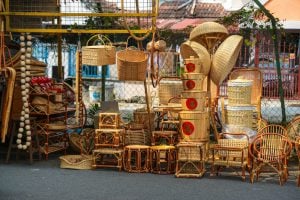At the age of 79, Yasmeen Lari can finally see a 30-year-old dream come to fruition: that of being able to walk the almost 2-kilometre distance between the Karachi Port Trust to the inner city where the 133-year-old Denso Hall stands. She wants to see present-day Karachi as a modern city but one that is rooted in its past and displayed adequately through its heritage, parks, open spaces and with encroachments removed.
The area she is referring to in the port city of Karachi has some of the most beautiful heritage buildings. Today these are used as godowns packed with unwieldy ware. The extra goods are dumped out on the pavements, making it impossible for pedestrians to walk without any impediment. Often they are forced to walk on the road chock-a-block with pushcarts and donkey carts on which the goods are loaded.
“I am the only one using natural, healthy materials and lots of trees. My work entails negligible carbon footprint”Yasmeen Lari
![The INTBAU Centre that Yasmeen Lari has been instrumental in establishing [image courtesy: Heritage Foundation of Pakistan]](https://dialogue.earth/content/uploads/2020/02/INTBAU-Centre-2019.jpg)
Lari’s list of accolades is long and peppered with prestigious awards. Two years ago, she managed to set up the Pakistan chapter of the International Network of Traditional Building, Architecture and Urbanism (INTABU). In 2019, her name was among the 60 women who contributed most to 60 years of UNESCO; in 2018, she won the World Habitat Awards for the Pakistan chulha (low cost smokeless stoves that became an enterprise for rural women) and in 2016 she bagged the Fukuoka Prize for Asian Art and Culture from Japan. At home too, she has been lauded and bestowed with the highest civilian awards of Sitara-e-Imtiaz in 2006 and Hilal-i-Imtiaz in 2014.
But in the last two decades, it has become evident that the first female architect of Pakistan wants to help the city mitigate the “effects of climate change by reducing its carbon footprint” — a significant pledge coming from someone who recognises that the industry she is associated with is responsible for nearly 40% of global climate emissions.
Yasmeen Lari wants to make amends.
Eco-urbanism
The graduate from The School of Architecture at Oxford Brookes University does not want to wind back the clock to the 1960s. But being a staunch supporter of eco-urbanism — which she says equals traditional urbanism where the “positive elements of yesterday can still be nourished and nurtured” — she insists one does not need to build anew as it “only leads to leaving a carbon footprint”.
She has her eyes on reviving the already available low-rise high-density buildings that are eco-friendly and an antidote to the multi-storey towers.
“Less construction of multi-storey [buildings] will mean less carbon emissions. We are fortunate the inner city has many such buildings already,” Lari told thethirdpole.net.
She added that this will also lead to less space for vehicles and more for humans. “It will mean people will start talking to each other,” said Lari, who recently won the prestigious 2020 Jane Drew Prize, that recognises the contributions of women architects.
Back in the 1970s, she had modelled Lahore’s Anguri Bagh housing project along those very lines. “We made sure every apartment had a courtyard for women to tend to their chickens and to grow vegetables, which was what they had demanded, [they could also] keep an eye on their kids playing down below on the streets.”
36% of global energy is used in buildings and construction; cement is the cause of 8% of global emissions. With these statistics in mind, Lari said it was imperative for architects to “lower the carbon footprint” in whatever they do.
Lari heads the Heritage Foundation of Pakistan, an institution set up in 1980, that has documented over 600 historic buildings in Karachi, and is part of the Marriott Road. She is excited by the prospect of getting involved in bringing the port city back to its past glory after the Supreme Court ordered the removal of illegal encroachments last year.
Walking from Kemari to the heart of Karachi
On paper, for now, she has divided the almost 2 kilometres into 13 trails. Work has already started on the first one (450 feet long/137 metres), to bring some order to the chaos. “We are calling it Sabz Rahguzar (Green Alley) where the pavements will be made of terracotta tiles,” she said. She showed me the tiles being made by the impoverished women of Makli (which hosts Asia’s largest necropolis, about 105 kilometres from Karachi), who have learnt the skill of making these ceramic tiles.
![Yasmeen Lari at the Makli necropolis [image by: Zofeen T. Ebrahim]](https://dialogue.earth/content/uploads/2020/02/Makli-necropolic-photo-by-zofeen-T.-Ebrahim.jpg)
“The cleaning of the facade of 12 heritage buildings, including Denso Hall, has already been carried out. Once the encroachments are removed, we will plant four Miyawakee style urban forests in the middle of the street,” she told thethirdpole.net.
Retrofitting
The buildings that house the godowns are still environmentally friendly and, Lari said that if she had her way, she would turn them back to residences. “I would like to change the land use in that neighbourhood,” she said. While most buildings are “solidly built”, those that have become structurally unsafe can be strengthened by retro-fitting. And if it is all about making profits, she said the same buildings could be turned into bed and breakfast places.
But even if Lari does not want to turn the clock back for these buildings, she hopes that on Sundays, when business is closed, the street is used for other activities, such as street theatre, music, and food stalls.
Yasmeen Lari is not the first to talk of revamping old quarters of town into food and activity centres, where she differs from others is on material. “I am the only one using natural, healthy materials and lots of trees. My work entails negligible carbon footprint,” she said.
Loath to displace people and disrupt their livelihood her plan ensures the provision of an alternative space for push carts vendors in a separate enclave, which would require registration so exploitative elements making a living off renting the carts are sifted out.
Green architecture: Lime, mud and bamboo
The architect remains “quite perturbed” by the Supreme Court’s withdrawal of its 2017 ban on construction of high-rise buildings. The ban had been imposed after hearing a case on the non-availability of potable water and deteriorating sanitation conditions in Karachi. But in 2018, a bench of the SC stated, “As per Sindh Building Control Authority (SBCA) laws, high-rise buildings can be constructed.”
To Yasmeen Lari, the multi-storey towers were nothing but bad news. “The retraction by SC will only play havoc with climate and destroy the urban environment,” she exclaimed.
She also has reservations about the government’s announcement that it will build five million affordable homes for the less fortunate as part of its Naya Pakistan Housing Programme, for which over 1.98 million people have applied.
Lari said new housing is definitely a requirement but highlights the cost of constructing each structure: one home will cost nothing less than PKR 1.5 million (USD 9,712).
“It is definitely not for the poor,” she said. Pakistan has a per capita GDP of less than USD 1,400 per annum.
In addition, the programme will require huge amounts of concrete, steel, aluminium and glass — all elements that add to global emissions. Proposing hybrid architectural practices which she has experimented with and executed with satisfaction for rural communities across Pakistan, Lari suggested replacing carbon intensive materials with lime, mud and bamboo.
“Mud is available everywhere, in plenty, and it can be recycled. Bamboo can be grown and harvested every two years,” she said. As for lime, she said, it is the only material that uses fuel. “But you do not need to cut trees or burn any fossil fuel.”
She has built enduring homes and communal shelters for 40,000 people who were affected by the 7.8 magnitude earthquake in Pakistan-administered Kashmir and the super floods of 2010. Her work in these areas has stood the test of time.
“We can make a home (with one bedroom, a bathroom, a kitchenette and place for a handpump) in a village in PKR 27,000 (USD 17d). Maybe it will take us a little more to build a house in a city but a house costing PKR 1.5 million is just too much!”
Further, she pointed out that low cost housing does not mean the structures are unsafe. “In fact, the cement used today is of such poor quality that it won’t withstand strong earthquakes,” she said.
![Low cost buildings, that are both resilient and climate appropriate, need to be supported [image courtesy: Heritage Foundation of Pakistan]](https://dialogue.earth/content/uploads/2020/02/Flat-roof-Shelter-2011.jpg)
Yasmeen Lari’s quest
Lari gave up her practice in 2000 to devote her time to humanitarian architecture, the conservation of heritage, and to introduce the concept of “social and ecological justice” using “low cost, zero energy, zero waste” to Pakistan. Winking mischievously, she said she is “atoning” for all her sins — after all, Yasmeen Lari has designed some of Karachi’s biggest buildings which are made of cement, glass and granite.
“Architects need to take carbon and climate change seriously and change the way they think. Taking it up as a challenge to design climate-friendly buildings, they can influence the people they are designing for as well as the product manufacturing community,” said the septuagenarian who is designing a course for architectural students to make them aware of the value of low carbon, hybrid structures.
![<p>Yasmeen Lari is one of Pakistan’s most feted architects, both at home and abroad [image by: Zofeen T. Ebrahim]</p>](https://dialogue.earth/content/uploads/2020/02/Yasmeen-Lari.jpg)


![The women of Rahul Nagar live in concern of the impact of the river eating up the lands [image by: Manoj Singh]](https://dialogue.earth/content/uploads/2020/02/नदी-की-कटान-से-प्रभावित-राहुल-नगर-की-महिलाएं-300x225.jpg)



![Sveinung Rotevatn, Norway's Minister for Climate and the Environment [image courtesy: Norwegian Ministry of Climate and Environment]](https://dialogue.earth/content/uploads/2020/02/Sveinung-Rotevatn-300x169.jpg)
![The Rising Blue mural [image by: Waleed Khan / I Am Karachi]](https://dialogue.earth/content/uploads/2020/02/Rising-Blue-3-mural-by-Giuseppe-Percivati.-Photo-by-Waleed-Khan.-Courtesy-I-Am-Karachi-200x300.jpg)
